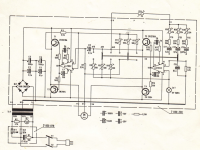This is a query about the strobe for the Thorens TD125 turntable. This can be used without modification in both 120 and 240V regions save for changes to wiring on the mains board/transformer. The strobe has a built-in 47k series resistor. The transformer (dual primary/secondary) is the same in both voltage regions.
Since the series resistor is not changed the strobe will need a 240V supply. How is this achieved in a 120V region? The schematic seems to show 120V connected across one of the primary windings and the strobe connected across both windings to get 240V, ie a step-up arrangement. Is this a recognised way of using the primary coils? I can't find any other instance of this kind of use on the web.
Since the series resistor is not changed the strobe will need a 240V supply. How is this achieved in a 120V region? The schematic seems to show 120V connected across one of the primary windings and the strobe connected across both windings to get 240V, ie a step-up arrangement. Is this a recognised way of using the primary coils? I can't find any other instance of this kind of use on the web.
Attachments
It’s a neon right?…. Change (or at least move it so it’s connected to the 110) the resistor to suit
It doesn’t need 240 to strike , hence the resistance
It doesn’t need 240 to strike , hence the resistance
Neons run at 60-70 V, hence always a series resistor is used for mains operation..
Check up, you need a smaller value for 110 compared to 220V
Check up, you need a smaller value for 110 compared to 220V
If you look at the circuit you will see that the neon circuit is connected across the 220V winding of the multi-tapped transformer input. When the fuse is placed for connection to 117V input the neon circuit still gets 220V.
If you look at the circuit you will see that the neon circuit is connected across the 220V winding of the multi-tapped transformer input. When the fuse is placed for connection to 117V input the neon circuit still gets 220V.
Oh yeah couldn't see that with that small picture ! 🙂 well spotted that man
The resistor will still be fed 240 (autotransformer style) from the 120 winding when you move the fuse.
Thanks for your replies. I assume in this autotransformer mode the power supplied by the transformer to the output will be reduced, eg from 15VA to 7.5VA?
Just higher current on the primary with the change from 240 to 120
The neon takes negligable current and is via the primary anyway.
The neon takes negligable current and is via the primary anyway.
I rebuilt my TD-125 about 10 years ago, bought new in 1975. The strobe had nerer worked right ( It flickered).
I am on 120V. The power supply voltage were correct but I was only getting 120V out of the transformer before the 47K resistor to the neon lamp. Bad transformer from the factory. After I replaced it the strobe worked fine. I guess that they sent the turntables with a bad primary for 240V to the 120V market, or I was just unlucky.
I am on 120V. The power supply voltage were correct but I was only getting 120V out of the transformer before the 47K resistor to the neon lamp. Bad transformer from the factory. After I replaced it the strobe worked fine. I guess that they sent the turntables with a bad primary for 240V to the 120V market, or I was just unlucky.
- Home
- Amplifiers
- Power Supplies
- Turntable strobe 120/240V power supply
